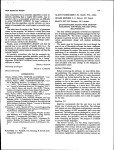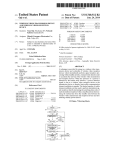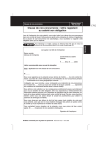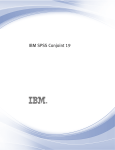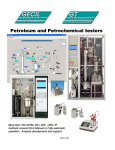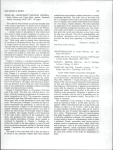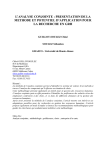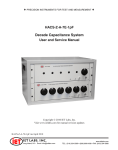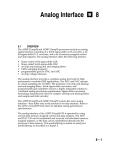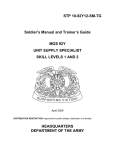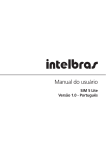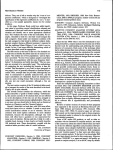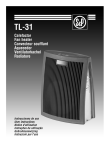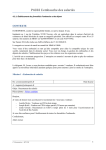Download To appraise the quality of the translations, a panel of language
Transcript
NEW BOOKS IN REVIEW
To appraise the quality of the translations, a panel of
language professors and bilingual marketing experts were
consulted. The panel selectively analyzed translations in
their language of expertise. In general, they agreed that
the overall translation quality is good. Exceptions were
noted for translations that were "too" literal ("transliterations" over decentered, conceptual equivalents), nonconcurrence with gender choice for some nouns, inconsistencies with the endings for adjectival nouns, and a
few misspellings.
An interesting feature of the glossary is that, in some
cases, the English term is given as the "translation" because it is used frequently in the foreign language. For
example, the term "marketing" is used in the five other
languages along with other choices, but the English term
has a more extensive meaning than the translations. Synonyms are given when applicable, but without clarification of usage.
This book appears to be unique in terms of the number
of languages included and the specialization on marketing research. Other marketing glossaries are only bilingual (Lieu 1983, English-French; Fisher-Rossi 1979,
Spanish-English) or specialize only in advertising terms
(Koschnick 1987, English-German).
The glossary is a solid contribution that should help
marketing research practitioners and users around the
world understand each other better. It should be considered a useful reference for language translations and a
"should have" addition to intemational business libraries.
117
ware's ACA System (Carmone 1987)—the other major
conjoint programs—CONJOINT LINMAP can be used
to analyze data from either full-profile or tradeoff studies.
The package is shipped on one disk (the application
program, sample datafiles, and two utility programs) with
a detailed user's manual. This version of LINMAP includes enhancements for simulation, validation, data
cleaning, and other features. However, some of the flexibility of the original mainframe version is limited—
nonconjoint applications are not possible and a few options that are user-specified in LINMAP IV are preset in
the PC version. Bretton-Clark believes this is an advantage as the options chosen are "near-optimal" for most
applications, whereas user specification could lead to inappropriate choice of options; we say more on this design decision subsequently.
Installation
Installation of CONJOINT LINMAP from the floppy
onto a hard disk is straightforward. The program works
also from the floppy drive alone. However, the user must
insert a programmable hardware key that is provided with
the software into the parallel printer port in order to run
the program. This key is used to ensure that the program
can be run on only one machine at a time. The program
itself is not copy protected and backup copies can be
made. The printer is always available for use as it is
plugged into the key. To some users, such a key will be
an inconvenience and perhaps even an annoyance, but it
appears to be a necessary feature if unauthorized copying
HuMBERTO VALENCIA
of software is to be minimized.
American Graduate School of
International Management (Thurtderbird)
CONJOINT LINMAP needs no special equipment other
than the key provided with the program disk. The softPATRIYA TANSUHAJ
ware runs on IBM and compatible PCs with at least 256K
MICHELLE MCCANN
of memory, though 640K is highly recommended. The
Washington State University
program supports an XXX87 math coprocessor, but will
REFERENCES
run without one. As we show, the math coprocessor is
almost a necessity unless the researcher is in no hurry.
Fisher-Rossi, Konrad (1979), Glosario de Mercadeo (GlosThe linear programming technique used in calculating
sary of Marketirtg). Mexico: Editorial Limusa.
Koschnick, Wolfgang J. (1987), Ertglish-Gerrrtart Startdard utilities takes a great amount of computation time. The
Dictiortary ofAdvertisirtg, Mass Media artd Marketirtg. New program requires DOS 2.0 or higher, and either a color
York: French and European Publications, Inc.
or monochrome monitor can be used. An unlimited numLieu, J. (1983), Ertglish-Frertch Glossary of Marketing Terms. ber of product features and cards can be handled.
The World Alrrtanac and Book of Facts (1989). New York:
Pharos Books.
Estimating Utility Functions
The initial menu lets the user select from among the
following options.
CONJOINT LINMAP. New York: Bretton-Clark, 1989.
1. New analysis
CONJOINT LINMAP is Bretton-Clark's latest addi2. Retrieve previous analysis
tion to its suite of programs for use in conjoint analysis
3. Run simulations
projects, joining CONJOINT DESIGNER (Carmone
4. Screen/clean data
1986), CONJOINT ANALYZER (Green 1987), SIM5. Analyze holdout data
6. Calculate group utility function
GRAF, and BRIDGER (Albaum 1989). It is a menu7. Exit
driven personal computer version of the mainframe program LINMAP IV, a nonmetric optimization technique
for analysis of conjoint and other types of data developed
CONJOINT LINMAP requires a design file and a daby Srinivasan and Shocker (1973a,b). Unlike Brettontafile as input. The datafile contains either full-profile or
Clark's CONJOINT ANALYZER and Sawtooth Softtradeoff table data and the design file contains either card
118
or table specifications. A full-profile design file created
by CONJOINT DESIGNER can be read without modification. The program is flexible enough to be used with
any full-profile design file written as an ASCII file, if it
follows tiie structure shown in the Appendix to the user's
manual. This structure may be necessary if interaction
terms are to be estimated and a non-CONJOINT DESIGNER design file is to be used. Tradeoff design files
also must be in ASCII format and structured as specified
in the manual.
CONJOINT LINMAP is fairly fiexible in how input
datafiles can be structured. ASCII files must be used and
structured as shown in the manual. One acceptable version for full-profile data is the basic form supported by
Version 2 of CONJOINT ANALYZER.
Assuming a new analysis, the program requests the
various file names and type of data (full profile or tradeoff tables). The user then is asked whether the data are
weighted. This is a useful option, especially for applications in forecasting from "nonrepresentative" samples.
For each feature, the user indicates whether it is qualitative (part-worth model) or quantitative (ideal point or
vector model). For quantitative features, values must be
entered for each level of the feature. Any errors can be
corrected after all features have been specified as there
is an option to review what has just been entered.
The next step is to specify the constraints for selected
features. This is one of the capabilities of CONJOINT
LINMAP tiiat differentiates it from CONJOINT ANALYZER and the ACA System. That is, one sets constraints prior to calculating individual utilities instead of
first calculating the utilities and then forcing monotonicity as is done in other conjoint software. The user can
automatically force the individual's utilities to be at least
weakly monotone on features that, a priori, are assumed
to be monotone. To use this capability, the levels for the
part-worth model features must be in a specific order. If
they are not, a utility program is included to rearrange
the levels. If an ideal point model is being used, additional constraints on shape of curve (concave, convex,
unknown) can be specified. Finally, for vector models,
the only constraint possible is whether it is increasing or
decreasing.
After specifying the form of the input data (rating or
rankings, card numbers included, etc.), one calculates
the utilities for each individual for each feature level.
These utilities are stored in a file that can be used for
further analysis by CONJOINT LINMAP or otiier software (e.g., SIMGRAF and BRIDGER).
Data Cleaning
Once the utilities have been calculated, one can see
how well the predicted values fit the actual data. This is
done by looking at pairs of stimuli and matching the predicted preferences with actual preferences. A table of
violations is presented that shows the distribution over
the group of respondents of the percentage of pairs violated. This is the goodness-of-fit measure used in CON-
JOURNAL OF AAARKETING RESEARCH, FEBRUARY 1991
JOINT LINMAP and is included for each individual in
the utility file for further use as a screening variable.
One can view individual respondent data and, on the
basis of a user-specified threshold value, delete respondents with poor fit (i.e., at or above threshold violations).
Group Statistics, Holdout Data Calculations, and
Simulations
Once the data are "cleaned," the user can calculate
average utilities for the sample, evaluate holdout cards
or tables, and run simulations. These steps are done by
simply requesting the appropriate option from the main
menu, specifying the names of the files, defining the
products to be simulated, and so on. These steps are
straightforward in this package. For simulations, up to
30 products can be analyzed at a time by using a first
choice or maximum utility model.
SAMPLE RUNS
Included with CONJOINT LINMAP are two sample
design files and datafiles, one each for full-profile and
tradeoff table tasks. The manual is well written and easy
to follow, so we were able to run the sample data with
no problems. We used a Compaq Plus with a 386 chip
and math coprocessor and a Toshiba 3100 with only a
286 chip (Norton Computing Index of 16.5 and 8.3, respectively) to run the sample with full-profile data. The
computing time per respondent was .45 minutes for the
Compaq and 12 minutes for the Toshiba. With a large
number of respondents and only a 286-based machine,
one could run the analysis overnight. The tradeoff sample data were run on a UNISYS with a 386 chip, but no
coprocessor, and a Zenith Supersport with an 8088 chip
and a math coprocessor. The compute time per respondent was .50 minutes for the UNISYS and 5 minutes for
the Zenitii.
We conclude from the sample runs that it is best to
have a 386 chip or at least a math coprocessor with any
machine. Ideally, one should have both to run CONJOINT LINMAP in a "reasonable" amount of time. After we calculated the individual utilities, it was very easy
to calculate group statistics and run a few simulations.
Even the naive user should have little difficulty in using
CONJOINT LINMAP with his or her own data, as long
as the input files are in proper format.
Summary
A general question is whether the significantly long
time needed to run a nonmetric algorithm with constraints is worth the effort. Carmone, Green, and Jain
(1978), Jain et al. (1979), and Wittink and Cattin (1981)
have found ordinary least squares (OLS) procedures to
be about as good as the nonmetric procedures under many
conditions.
The researcher must ask whether or not his or her data
can be analyzed best by using a nonmetric procedure;
119
NEW BOOKS IN REVIEW
many researchers feel a nonmetric algorithm is more intuitively satisfying than a simple OLS model. Any researcher who is so persuaded would have no difficulty
in using CONJOINT LINMAP. Its major weakness is
derived from the algorithm, not the software—to run a
sample of reasonable size would require a powerful computer.
One other item of concem is the "fixing" of parameter
values by the program. We believe it would have been
better to leave as much to user choice as technically and
practically feasible, rather than making decisions for the
user. The "optimal" parameter values could have been
set as default values for the naive user. Perhaps subsequent versions will have this flexibility.
Finally, users of CONJOINT LINMAP will find the
manual easy to use and full of helpful hints (e.g., the
discussion of price elasticity and segmentation). Even
the experienced conjoint analysis researcher will find the
material helpful.
In summary, researchers who fmd the nonmetric optimization techniques appealing probably would be willing to accept increased computing time for a "better"
algorithm. CONJOINT LINMAP would certainly be the
software of choice.
GERALD ALBAUM
University of Oregon
FRANK J. CARMONE
Drexel University
REFERENCES
Albaum, Gerald (1989), "BRIDGER and SIMGRAF," Jourrtal of Marketing Research, 26 (November), 486-8.
Carmone, Frank J. (1986), "CONJOINT DESIGNER," Jourrtal of Marketing Research, 23 (August), 311-12.
(1987), "ACA System for Adaptive Conjoint Analysis," Jourrtal of Marketing Research, 24 (August), 325-7.
-, Paul E. Green, and Arun K. Jain (1978), "The Robustness of Conjoint Analysis: Some Montd Carlo Results,"
Journal of Marketing Research, 15 (May), 300—5.
Green, Paul E. (1987), "CONJOINT ANALYZER," Journal
of Marketing Research, 24 (August), 327-9.
Jain, Arun K., Franklin Acito, Naresh K. Maihotra, and Vijay
Mahajan (1979), "A Comparison of Internal Validity of Altemative Parameter Estimation Methods in Decompositional
Multi-Attribute Preference Models," Journal of Marketing
Research, 16 (August), 313-22.
Srinivasan, V. and A. Shocker (1973a), "Linear Programming
Techniques for Multidimensional Analysis of Preferences,"
Psychometrika (September), 337-69.
and
(1973b), "Estimating Weights for Multiple Attributes in a Composite Criterion Using Pairwise
Judgments," Psychometrika (December), 473-93.
Wittink, Dick R. and Philippe Cattin (1981), "Altemative Estimation Methods for Conjoint Analysis: A Mont6 Carlo
Study," Journal of Marketing Research, 18 (Febniary), 101—
6.
RAGTIME 3.0. Narbeth, PA: Bruning & Everth Softwarepartner Gmbh.
ALDUS PAGEMAKER 3.02. Seattle, WA: Aldus.
QUARK EXPRESS 2.11. Denver, CO: Quark.
READY SET GO! Paramus, NJ: Letraset.
QUESTIONNAIRE DESIGN WITH DESKTOP
PUBUSHING SOFTWARE FOR THE APPLE
MACINTOSH PC
The four software programs reviewed are representative of desktop publishing software packages for the Apple Macintosh PC. The review compares the software
programs in general and also in the particular context of
survey questionnaire design with desktop publishing
software.
The reader must be forewarned that even though the
ease of use of Macintosh software has been a hallmark
for Apple, desktop publishing software requires a higher
order of diligence to master. The reason is that desktop
publishing is an unfamiliar discipline for most academicians. Besides mastering a new vocabulary, the user
must master commands that are not as intuitive as those
in many Mac software applications. Nonetheless, we believe the time invested in mastering the software will be
well rewarded with time savings in the designing of
questionnaires alone.
Desktop Publishing
Before reviewing the software, we must define desktop publishing. The simplest definition is that desktop
publishing is the ability of software to create documents
in virtually any format desired by the user. The user, in
essence, is able to create a multitude of formats, depending on his or her needs, by controlling the text,
graphics, and creation of the visual layout of the information before publishing, at a micro level. This ability
minimizes one's dependence on outside resources who
are "experts" in such matters. One thing the software
cannot do for the user is supply creativity in undertaking
the layout and related activities. The software allows for
creativity to take place readily, but it must be supplied
by the user.
RagTime 3.0
RagTime recommends that the user have two disk
drives, one of which must be a hard disk. The software
will operate on most Macintosh configurations, provides
basic color support, is HFS compatible, and is not copy
protected. The software comes packaged in a vinyl container with about a 350-page manual that includes a fivelesson tutorial, five glossaries, and two 800K formated
disks containing the program. The program is available
in several foreign languages.
The newest version, 3.0, has many improvements,
ranging from a cleaned-up user interface to expanded color
capabilities. This version will do color separations, mail
merge, macros, and font sizes up to 999 pts., as well as
having 90-degree rotation capability and improved file
importation capabilities. Additional printing options are




